To stay dry while cycling in the city during rain, gear up with a waterproof jacket, rain pants, and fenders to shield against spray. Use waterproof gloves and shoe covers to keep your extremities dry. Keep your bike well-maintained and brakes adjusted for slippery conditions. Route choice matters too—opt for bike paths and avoid flood-prone areas. Layer your clothing for warmth and improve visibility with lights. There's more you can do to enhance your wet weather rides.
Key Takeaways
- Wear a waterproof jacket and pants to keep your body dry during rainy rides.
- Use waterproof accessories like gloves and shoe covers to protect your extremities from getting wet.
- Ensure your bike has fenders to shield against road spray and mud while cycling.
- Choose routes with dedicated bike paths to minimize interactions with traffic and reduce exposure to rain.
- Regularly clean and reproof your waterproof gear to maintain its effectiveness against moisture.
Essential Gear for Wet Weather Cycling

When you're cycling in the rain, having the right gear makes all the difference in staying dry and comfortable.
Start with a waterproof jacket featuring breathable membranes to prevent overheating. Pair it with rain pants for full leg protection, especially during commutes or long rides.
Don't forget bike fenders; they shield you from road spray and mud, making your ride more enjoyable.
Waterproof accessories like gloves, socks, and shoe covers are vital for keeping your extremities dry.
Reflective gear enhances visibility, which is crucial in low-light conditions.
Consider layering options, as they let you adjust warmth and protection based on the weather.
With the right gear, you can embrace rainy rides confidently.
Safety Precautions to Keep in Mind

Cycling in the rain can be perilous if you don't take the right safety precautions.
First, ride slowly to maintain control on slippery surfaces and avoid sudden movements or sharp turns. Increase your following distance from vehicles, and use gentle braking to prevent skidding. Keep a relaxed grip on the handlebars.
Ride cautiously in the rain; slow down, maintain distance, and avoid sudden movements for better control.
Be mindful of road hazards like puddles, which may hide potholes, and slippery surfaces such as metal grates. Wet leaves and storm drains can also pose a risk.
Enhance your visibility by wearing bright, reflective clothing and using waterproof bike lights. Always signal your intentions clearly and make eye contact with drivers at intersections.
Lastly, ensure your bike is well-maintained for optimal performance.
Choosing the Right Route for Rainy Days
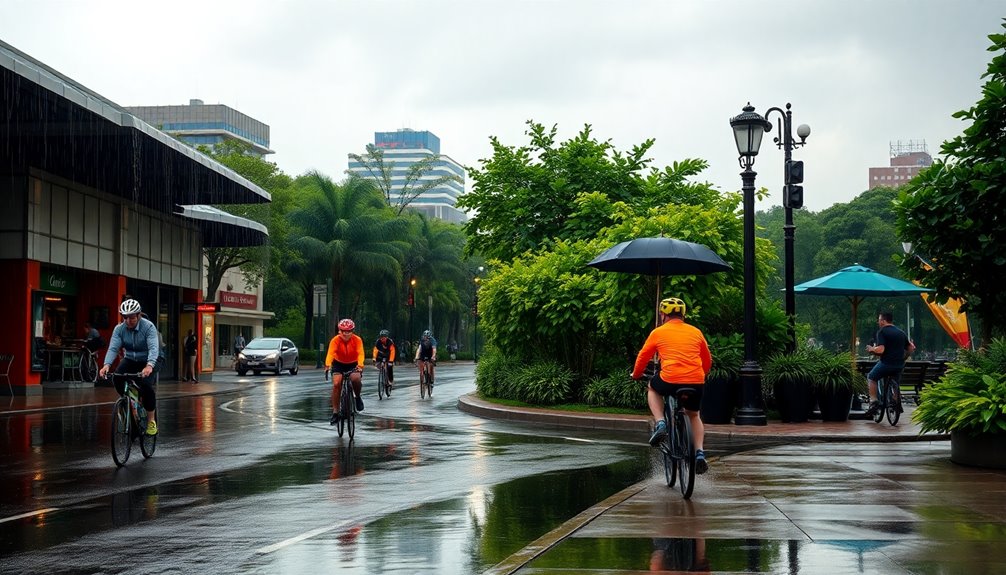
Riding in the rain not only requires attention to safety but also a smart approach to route selection. First, avoid flood-prone areas to keep your ride safe.
Look for routes with dedicated bike paths to minimize interactions with traffic, and choose smooth surfaces to reduce accident risks. Opt for lower traffic volumes to enhance your safety.
Consider visibility; select well-lit routes for those gloomy, rainy days. Utilize linear parks for scenic, flat rides, and check Google Maps or GPS devices for bike-friendly paths.
Monitor local rainfall patterns and wind direction to plan effectively. Lastly, know the locations of bike shops and restrooms along your route for added convenience.
Being strategic about your route can make your rainy ride much more enjoyable, especially since regional water parks often have areas that can provide shelter during sudden downpours.
Importance of Bike Maintenance

Although the thrill of cycling in the rain can be invigorating, ensuring your bike is well-maintained is crucial for a safe and enjoyable ride. Proper maintenance reduces the risk of accidents, especially in wet conditions where faulty brakes or under-inflated tires become hazardous.
Regularly checking key components like brakes, tires, and the chain can enhance performance and efficiency, making your rides smoother. Don't forget to adjust tire pressure for better traction on slippery roads.
Cleaning your bike after rides protects against rust and damage. Additionally, using advanced filtration systems can help keep your bike's components free from debris that may cause wear over time. By keeping your bike in top shape, you not only save money on costly repairs but also support sustainable urban mobility, making your cycling experience both reliable and enjoyable.
Accessories That Enhance Comfort
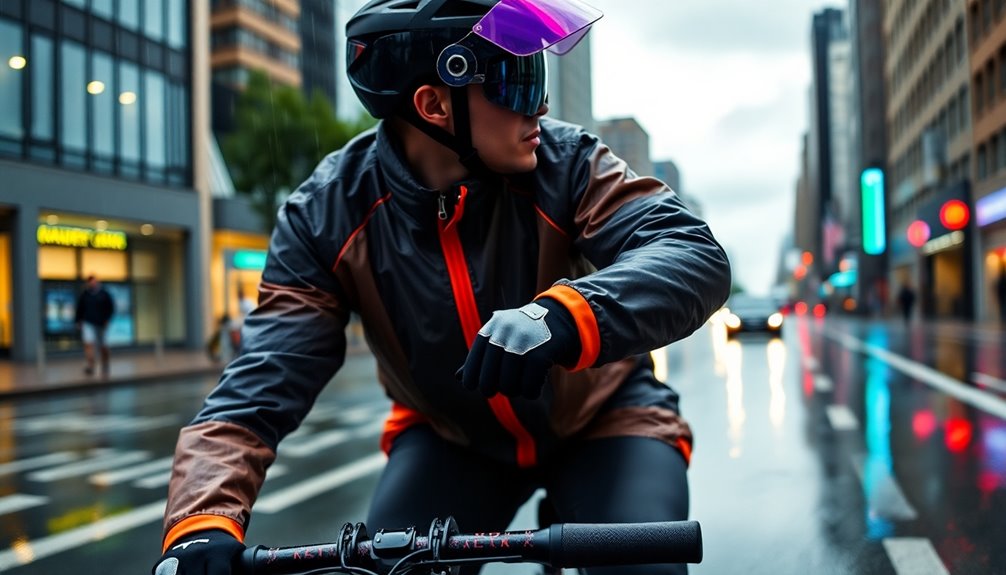
When you're caught in the rain, having the right accessories can make all the difference in your comfort level. Waterproof jackets and pants are essential for keeping you dry, featuring taped seams and breathable materials that prevent overheating.
Don't forget waterproof gloves to maintain grip and warmth on the handlebars, and consider overshoes to keep your feet warm and dry. Reflective gear is also crucial, enhancing your visibility in low-light conditions and ensuring safety while you ride.
By investing in these accessories, you can transform a soggy ride into a manageable experience, allowing you to focus on the road ahead rather than the discomfort of wet clothing.
Stay dry and comfortable, and enjoy your ride!
Staying Hydrated While Riding
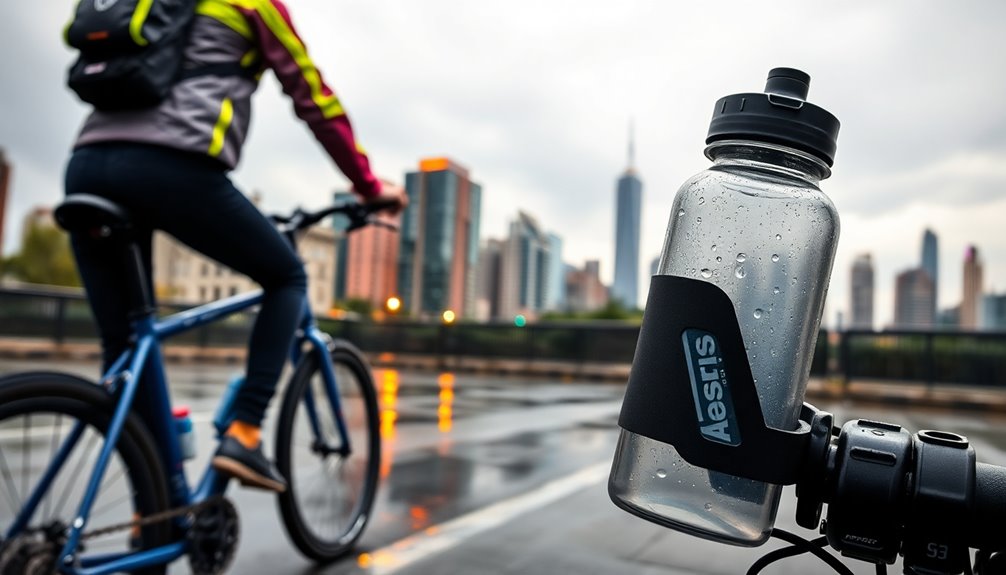
Staying dry in the rain doesn't just mean keeping your gear waterproof; it also involves ensuring you stay hydrated while cycling. Hydration is crucial for maintaining your performance and body temperature, even in wet conditions.
Aim to drink about 20-24 ounces of fluid per hour during your ride. Regular drinking intervals prevent dehydration, so don't wait until you're thirsty. Consider adding electrolytes to your fluids, as they help maintain balance and prevent muscle cramps. Incorporating healthy hydration options such as electrolyte drinks or smoothies can further enhance your hydration strategy.
Monitor your sweat rate and adjust your intake based on how much you lose. Also, pay attention to urine color; dark urine signals dehydration. Hydrating properly keeps you feeling strong and energized, no matter the weather.
Effective Riding Techniques in the Rain

Riding in the rain requires specific techniques to ensure your safety and maintain control. When braking, use a light touch to prevent skidding, and pump your brakes to clear water from the rims.
Always apply the rear brake first, especially during emergency stops, and avoid slamming on your brakes on wet surfaces. If you have disc brakes, use them for better performance in these conditions.
Be cautious of road hazards; steer clear of metal grates, painted lines, and puddles. Slow down when approaching slippery surfaces and consider alternative routes.
Finally, choose paths with fewer hazards and stay informed about the weather, so you can adapt your ride as needed.
Layering Your Clothing for Optimal Warmth
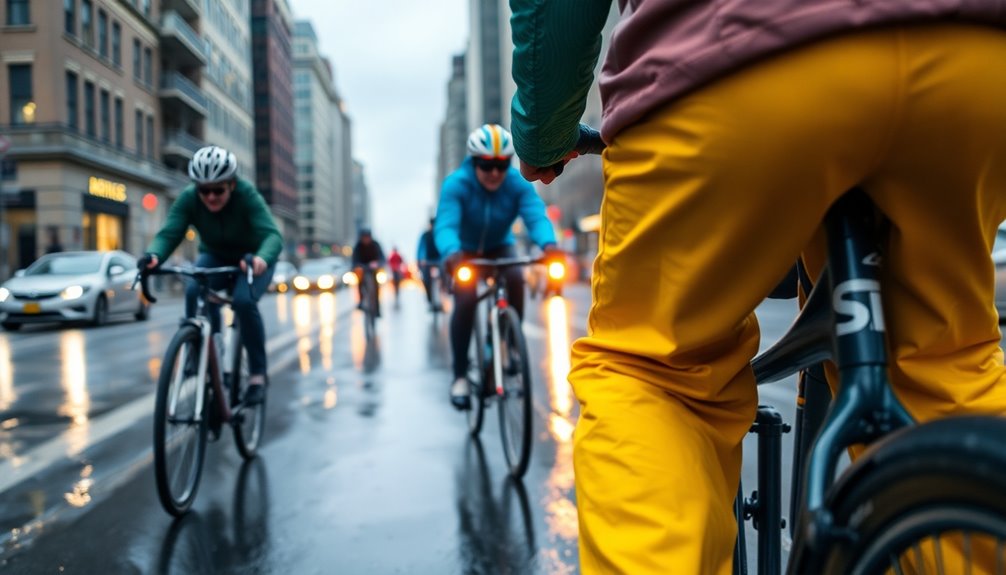
Maintaining control and safety while cycling in the rain is only part of the equation; staying warm and dry is just as important.
Layering your clothing is key. Start with a moisture-wicking base layer, like merino wool or a polypropylene blend, to regulate your temperature and keep sweat away from your skin.
For added warmth, choose a snug midlayer, such as a long-sleeved jersey, that allows moisture to escape.
Finally, top it off with a breathable, waterproof jacket to shield against wind and rain.
Avoid cotton, as it retains moisture and can lead to discomfort.
This layered approach not only conserves energy but also ensures you're comfortable throughout your ride, no matter the weather conditions.
Visibility Tips for Rainy Conditions
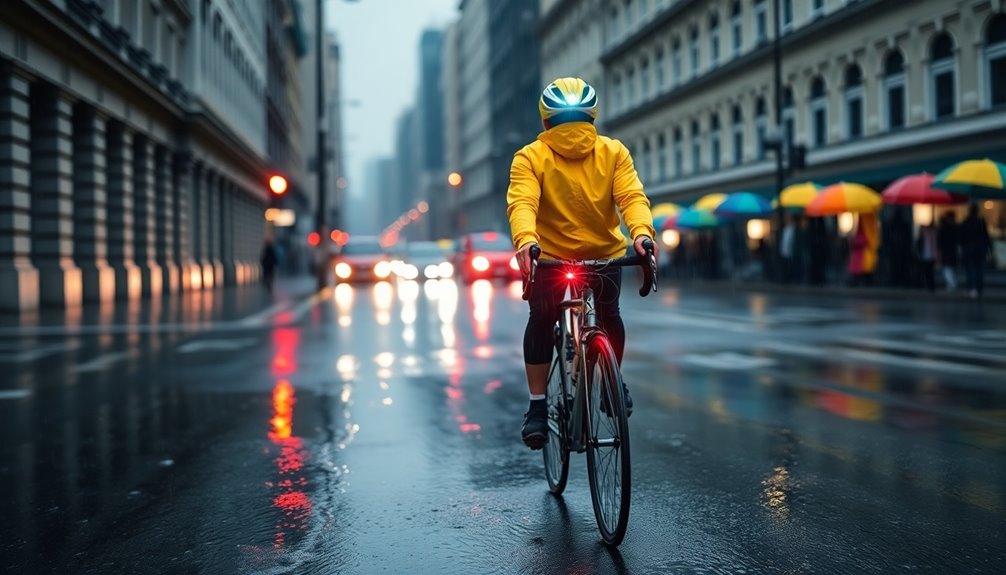
Although cycling in the rain can be challenging, ensuring you're visible is crucial for your safety. Equip your bike with flashing lights—these are more effective in low visibility.
Make sure your lights have an IPX5 rating or higher to handle heavy rain and angle your front light downward to avoid blinding oncoming traffic. Wear bright neon colors and reflective materials to stand out against gray backgrounds.
Consider yellow or light orange lenses for your cycling glasses to enhance contrast. Always check that your lights meet legal visibility standards. Additionally, using a high-capacity battery for your lights will ensure they last longer during your rides.
Lastly, maintain awareness of your surroundings and ride defensively; reduced speed and increased braking distance are key in wet conditions. Stay safe and be seen!
Preparing for Post-Ride Comfort

After navigating the challenges of visibility in rainy conditions, you'll want to focus on how to stay comfortable once your ride is over.
First, change into dry clothes quickly to avoid discomfort and chill. Clean and dry your cycling gear to maintain its effectiveness, and reproof any waterproof clothing.
Store your gear in a well-ventilated area to prevent moisture retention. Don't forget to wash your bike after your ride; this keeps it in top shape and prevents rust.
Inspect components, lubricate the chain, and ensure everything's functioning properly.
Finally, maintain personal hygiene by washing hands and any exposed skin with warm water to remove dirt, making your post-ride experience as refreshing as your ride should be.
Frequently Asked Questions
Can I Cycle in Heavy Rain Without Special Gear?
You can cycle in heavy rain without special gear, but it's not the best idea.
You'll likely get wet and uncomfortable, which can affect your focus and safety. Without proper gear, you risk losing grip and increasing your chances of accidents on slippery surfaces.
If you decide to ride, just be extra cautious, slow down, and stay alert for hazards.
However, investing in some waterproof gear would definitely enhance your experience and safety.
How Do I Clean My Bike After Riding in the Rain?
You'd think a bike would love a shower after a rainy ride, right? But it's crucial to clean it properly.
Start with warm, soapy water and a sponge to scrub off mud. Focus on the drivetrain and hard-to-reach spots with a soft brush.
Dry it thoroughly with towels, especially metal parts. Don't forget to lubricate the chain afterward to prevent rust.
Store it in a warm, dry place, and your bike will thank you!
Are There Specific Tires for Wet Weather Cycling?
Yes, there are specific tires designed for wet weather cycling.
You'll find options like the Pirelli Cinturato Velo and Continental Grand Prix 4 Seasons that offer excellent grip and durability on wet surfaces.
Look for tires with softer compounds and grooved tread patterns to enhance traction. Lowering tire pressure slightly can also improve grip.
Make sure to check for puncture protection features, as they're crucial for safe riding in rainy conditions.
What Should I Do if I Get Caught in a Sudden Downpour?
If you find yourself caught in a sudden downpour, it can feel like you're swimming through a waterfall on wheels!
First, slow down to maintain control and avoid skidding. Look for shelter, like a bus stop or awning, until the storm passes.
If you can't stop, keep your speed steady and avoid puddles. Remember to stay visible; flashing lights can be a lifesaver.
Finally, embrace the adventure—it's just another story to tell!
How Can I Improve My Bike's Grip in Wet Conditions?
To improve your bike's grip in wet conditions, consider reducing your tire pressure slightly to increase the contact patch.
Opt for tires with effective tread patterns, like herringbone, to channel water away and enhance traction.
Regularly maintain your bike by checking tire wear and ensuring brakes function well.
Lastly, practice safe riding techniques, like slowing down before turns and avoiding standing water, to maintain control and reduce the risk of skidding.
Conclusion
Cycling in the rain can be a refreshing challenge if you're well-prepared. Did you know that cyclists are 60% more likely to get into an accident in wet conditions? That's why staying visible, maintaining your bike, and choosing the right routes are crucial. By investing in essential gear and layering properly, you can stay dry and comfortable. Embrace the rain, and with the right techniques, you'll find joy in every ride, no matter the weather!









